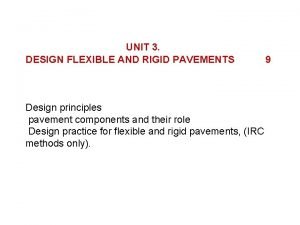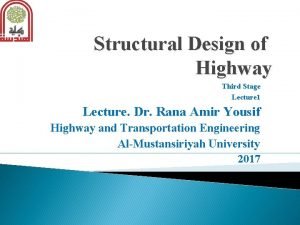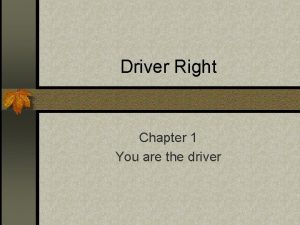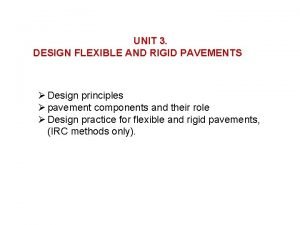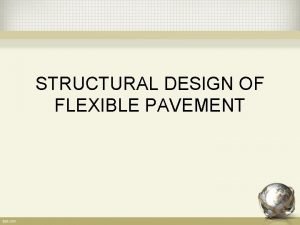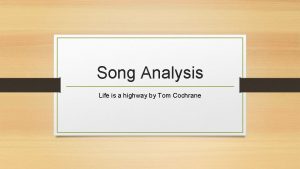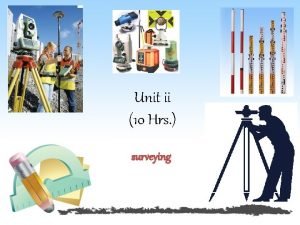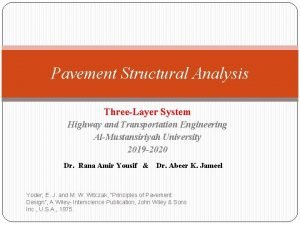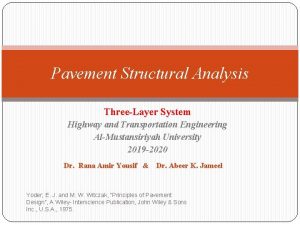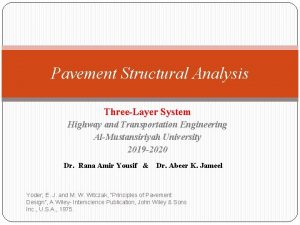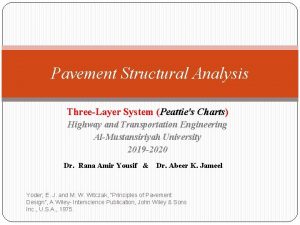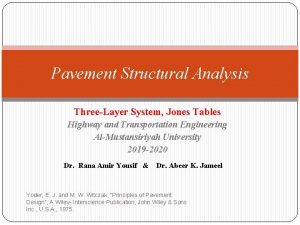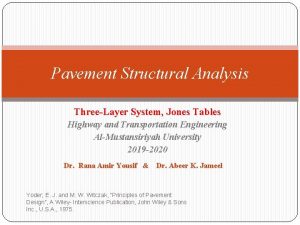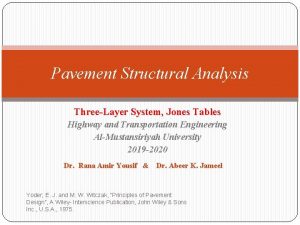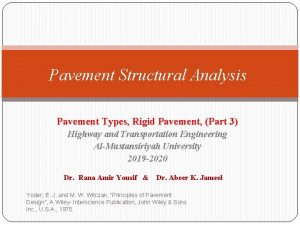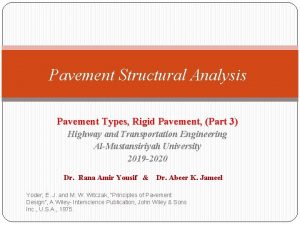Pavement Structural Analysis ThreeLayer System Highway and Transportation












- Slides: 12

Pavement Structural Analysis Three-Layer System Highway and Transportation Engineering Al-Mustansiriyah University 2019 -2020 Dr. Rana Amir Yousif & Dr. Abeer K. Jameel Yoder; E. J. and M. W. Witczak, “Principles of Pavement Design”, A Wiley- Interscience Publication, John Wiley & Sons Inc. , U. S. A. , 1975.

References Ø Nicholas J. Garber and Lester A. Hoel. ”Traffic and Highway Engineering”, Fourth Edition. Ø Yoder; E. J. and M. W. Witczak, “Principles of Pavement Design”, A Wiley. Interscience Publication, John Wiley & Sons Inc. , U. S. A. , 1975. Ø Yaug H. Huang, “Pavement Analysis and Design”, Prentic Hall Inc. , U. S. A. , 1993. Ø “AASHTO Guide for Design of Pavement Structures 1993”, AASHTO, American Association of State Highway and Transportation Officials, U. S. A. , 1993. Ø Oglesby Clarkson H. , “Highway Engineering”, John Wiley & Sons Inc. , U. S. A. , 1975. Yoder; E. J. and M. W. Witczak, “Principles of Pavement Design”, A Wiley- Interscience Publication, John Wiley & Sons Inc. , U. S. A. , 1975.

Three-Layer Systems Example (2, 11) Page 71: Given the three-layer system shown in Figure 2. 30 with a = 4. 8 in. (122 mm), q = 120 psi (828 k. Pa), h 1 = 6 in. (152 mm), h 2 = 6 in. (203 mm), E 1 = 400, 000 psi (2. 8 GPa), E 2 = 20, 000 psi (138 MPa), and E 3 = 10, 000 psi (69 MPa), determine all the stresses and strains at the two interfaces on the axis of symmetry. Yoder; E. J. and M. W. Witczak, “Principles of Pavement Design”, A Wiley- Interscience Publication, John Wiley & Sons Inc. , U. S. A. , 1975.

Three-Layer Systems Solution: Given k 1= 400, 000/20, 000 = 20 k 2= 20, 000/10, 000 =2 A=4. 8/6 = 0. 8 H= 6/6 = 1. 0

Three-Layer Systems From Table (2. 3) ZZ 1= 0. 12173 ZZ 2= 0. 05938 ZZ 1 -RR 1=1. 97428 k 1=20 k 2=2 A=0. 8 H=1. 0 ZZ 2 -RR 2= 0. 09268 Yoder; E. J. and M. W. Witczak, “Principles of Pavement Design”, A Wiley- Interscience Publication, John Wiley & Sons Inc. , U. S. A. , 1975.

Three-Layer Systems From Eq. 2. 24 = 120* 0. 12173 = 120 * 0. 05938 = 120 * 1. 97428 = 120 * 0. 09268 = 14. 61 psi = 7. 12 psi = 236. 91 psi = 11. 12 psi Yoder; E. J. and M. W. Witczak, “Principles of Pavement Design”, A Wiley- Interscience Publication, John Wiley & Sons Inc. , U. S. A. , 1975. ZZ 1= 0. 12173 ZZ 2= 0. 05938 ZZ 1 -RR 1=1. 97428 ZZ 2 -RR 2= 0. 09268

Three-Layer Systems From Eq. 2. 23 = 236. 91/20 = 11. 85 psi = 11. 12/2 = 5. 56 psi Yoder; E. J. and M. W. Witczak, “Principles of Pavement Design”, A Wiley- Interscience Publication, John Wiley & Sons Inc. , U. S. A. , 1975. K 1 =20 K 2 = 236. 91 psi = 11. 12 psi

Three-Layer Systems At bottom of layer 1, = 14. 61 – 236. 91 = - 222. 3 psi. From Eq. 2. 20 = 236. 91/400, 000 = 5. 92 x 10^-4 = -2. 96 X 10^ -4 Yoder; E. J. and M. W. Witczak, “Principles of Pavement Design”, A Wiley- Interscience Publication, John Wiley & Sons Inc. , U. S. A. , 1975. = 236. 91 psi = 14. 61 psi E 1=400000

Three-Layer Systems At top of layer 2 = 14. 61 – 11. 85 = 2. 76 psi. From Eq. 2. 20 = 11. 85/20, 000 = 5. 92 x 10^-4 = -2. 96 X 10^-4 Yoder; E. J. and M. W. Witczak, “Principles of Pavement Design”, A Wiley- Interscience Publication, John Wiley & Sons Inc. , U. S. A. , 1975. =11. 85 = 14. 61 psi E 2 = 20000

Three-Layer Systems At bottom of layer 2 = 7. 12 - 11. 12 = -4. 0 psi. From Eq. 2. 20 = 11. 12/20, 000 = 5. 56 * 10^-4 = -2. 78 * 10^-4 Yoder; E. J. and M. W. Witczak, “Principles of Pavement Design”, A Wiley- Interscience Publication, John Wiley & Sons Inc. , U. S. A. , 1975. =11. 12 = 7. 12 psi E 2 = 20000

Three-Layer Systems At top of layer 3 = 7. 12 - 5. 56 = 1. 56 psi. From Eq. 2. 20 = 5. 56/10, 000 = 5. 56 * 10^-4 = -2. 78 * 10^-4 Yoder; E. J. and M. W. Witczak, “Principles of Pavement Design”, A Wiley- Interscience Publication, John Wiley & Sons Inc. , U. S. A. , 1975. =5. 56 = 7. 12 psi E 3 = 10000

Three-Layer Systems THANKS FOR ATTENSION Dr. Rana Amir Yousif & Dr. Abeer K. Jameel Yoder; E. J. and M. W. Witczak, “Principles of Pavement Design”, A Wiley- Interscience Publication, John Wiley & Sons Inc. , U. S. A. , 1975.
 Rigid vs flexible pavement
Rigid vs flexible pavement Rigid pavement and flexible pavement
Rigid pavement and flexible pavement 3 parts of highway transportation system
3 parts of highway transportation system What are the parts of the highway transportation system
What are the parts of the highway transportation system Three parts of the highway transportation system
Three parts of the highway transportation system Flexible pavement vs rigid pavement
Flexible pavement vs rigid pavement Pavement structural design
Pavement structural design Life is a highway meaning
Life is a highway meaning Hub-and-spoke vs point-to-point airlines
Hub-and-spoke vs point-to-point airlines Cables and arches
Cables and arches Swot analysis of road transport
Swot analysis of road transport Garber
Garber Difference between rigid and flexible pavement
Difference between rigid and flexible pavement
